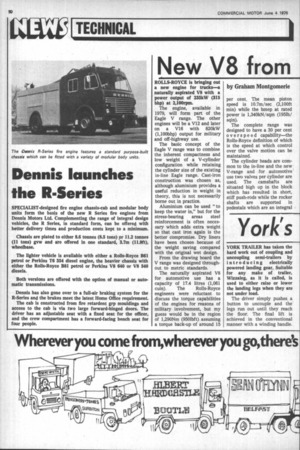New V8 from
Page 32

If you've noticed an error in this article please click here to report it so we can fix it.
by Graham Montgomerie
ROLLS-ROYCE is bringing out a new engine for trucks—a naturally aspirated VS with a power output of 235kW (315 bhp) at 2,100rpm.
The engine, available in 1979, will form part of the Eagle V range. The other engines will be a VI2 and later on a V16 with 820kW (1,100bhp) output for military and off-highway use.
The basic concept of the Eagle V range was to combine the inherent compactness and low weight of a V-cylinder configuration while retaining the cylinder size of the existing in-line Eagle range. Cast-iron construction was chosen as, although aluminium provides a useful reduction in weight in theory, this is not necessarily borne out in practice.
Aluminium can be used "to keep the water in," but for the stress-bearing areas steel reinforcement is often necessary which adds extra weight so that cast iron again is the better compromise. Dry liners have been chosen because of the weight saving compared with the original wet design.
From the drawing board the V range was designed throughout to metric standards.
The naturally aspirated V8 for automotive use has a capacity of 17.4 litres (1,061 cuin). The Rolls-Royce engineers were reluctant to discuss the torque capabilities of the engines for reasons of military involvement, but my guess would be in the region of 1,290Nm (9501bft) assuming a torque back-up of around 15 per cent. The mean piston speed is 10.7m/sec (2,100ft min) while the brnep at rated power is 1,340kNisqm (1951b/ sqin).
The complete range was designed to have a 30 per cent ov e r speed capability—the Rolls-Royce definition of which is the speed at which control over the valve motion can be maintained.
The cylinder heads are common to the in-line and the new V-range and for automotive use two valves per cylinder are used. The camshafts are situated high up in the block which has resulted in short, stiff push-rods while the rocker shafts are supported in pedestals which are an integral




























































































































